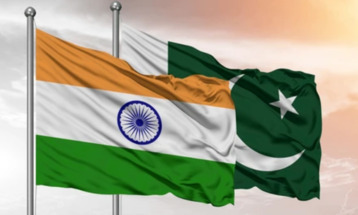-
India’s monsoon rains cover entire country but still down on average

The Indian-run weather office said, the country’s annual monsoon covered the entire country on Saturday (July 2). This year monsoon came six days earlier than usual, but rain totals are 5 per cent below average so far this season.
The monsoon, critical for farm output and economic growth in the world’s second-most populous country, arrived on the coast of the southern Kerala state on May 29, a couple of days ahead of usual, yet after a promising start the rains gradually tapered off, clocking an 8 per cent deficit in June, the Malay Mail reported, citing Reuters.
It said that last month’s patchy rains slowed the planting of rice, an essential summer crop.
India’s rice farmers have planted 4.3 million hectares with the grain so far this season, down 27 per cent from the same period last year, according to the report.
The progress of the monsoon, which delivers about 70 per cent of the country’s annual rainfall, is crucial for rice output and exports from India, the world’s biggest exporter of the grain.

Poor monsoon rains would further delay rice planting, stunt the crop and cut yields, leading to a drawdown in state inventories that would trigger export curbs to ensure sufficient supplies for the country’s 1.4 billion people.
India achieves Guinness World Record for constructing longest piece of road
The India Meteorological Department had said on Friday (July 1), India is likely to receive monsoon rainfall between 94 per cent and 106 per cent of the long-term average in July, the most crucial month for planting rice and a host of other summer crops such as corn, cotton, soybean and sugarcane.
The weather office defines average, or normal, rainfall as between 96 per cent and 104 per cent of a 50-year average of 87 cm for the entire four-month season beginning in June. Rain totals or between 90 per cent and 96 per cent are considered below average.
Death of three sisters spotlights India's dowry violence
Bountiful monsoon rains in July would ease concerns about the output of summer crops, promising higher incomes in the countryside where most Indians live. As almost half of the country’s farmland lacks irrigation, Indian farmers depend on the monsoon.
It should be noted that the farm sector employs more than half of the country’s population and accounts for nearly 15 per cent of India’s US$2.7 trillion (RM11.9 trillion) economy, Asia’s third-biggest.
Source: malaymail
You May Also Like
Popular Posts
Caricature
BENEFIT Sponsors BuildHer...
- April 23, 2025
BENEFIT, the Kingdom’s innovator and leading company in Fintech and electronic financial transactions service, has sponsored the BuildHer CityHack 2025 Hackathon, a two-day event spearheaded by the College of Engineering and Technology at the Royal University for Women (RUW).
Aimed at secondary school students, the event brought together a distinguished group of academic professionals and technology experts to mentor and inspire young participants.
More than 100 high school students from across the Kingdom of Bahrain took part in the hackathon, which featured an intensive programme of training workshops and hands-on sessions. These activities were tailored to enhance participants’ critical thinking, collaborative problem-solving, and team-building capabilities, while also encouraging the development of practical and sustainable solutions to contemporary challenges using modern technological tools.
BENEFIT’s Chief Executive Mr. Abdulwahed AlJanahi, commented: “Our support for this educational hackathon reflects our long-term strategic vision to nurture the talents of emerging national youth and empower the next generation of accomplished female leaders in technology. By fostering creativity and innovation, we aim to contribute meaningfully to Bahrain’s comprehensive development goals and align with the aspirations outlined in the Kingdom’s Vision 2030—an ambition in which BENEFIT plays a central role.”
Professor Riyadh Yousif Hamzah, President of the Royal University for Women, commented: “This initiative reflects our commitment to advancing women in STEM fields. We're cultivating a generation of creative, solution-driven female leaders who will drive national development. Our partnership with BENEFIT exemplifies the powerful synergy between academia and private sector in supporting educational innovation.”
Hanan Abdulla Hasan, Senior Manager, PR & Communication at BENEFIT, said: “We are honoured to collaborate with RUW in supporting this remarkable technology-focused event. It highlights our commitment to social responsibility, and our ongoing efforts to enhance the digital and innovation capabilities of young Bahraini women and foster their ability to harness technological tools in the service of a smarter, more sustainable future.”
For his part, Dr. Humam ElAgha, Acting Dean of the College of Engineering and Technology at the University, said: “BuildHer CityHack 2025 embodies our hands-on approach to education. By tackling real-world problems through creative thinking and sustainable solutions, we're preparing women to thrive in the knowledge economy – a cornerstone of the University's vision.”
opinion
Report
ads
Newsletter
Subscribe to our mailing list to get the new updates!






















